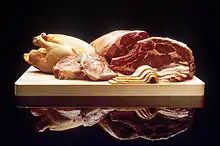Poaching (cooking)
Poaching is a cooking technique that involves cooking by submerging food in a liquid, such as water, milk, stock or wine. Poaching is differentiated from the other "moist heat" cooking methods, such as simmering and boiling, in that it uses a relatively low temperature (about 70–80 °C (158–176 °F)).[1] This temperature range makes it particularly suitable for delicate food, such as eggs, poultry, fish and fruit, which might easily fall apart or dry out using other cooking methods. Poaching is often considered a healthy method of cooking because it does not use fat to cook or flavor the food.[2]

Variations
Shallow poaching
This moist-heat cooking method uses a sautoir or other shallow cooking vessel, heat is transferred by conduction from the pan, to the liquid, to the food. Shallow poaching is best suited for boneless, naturally tender, single serving size, sliced or diced pieces of meat, poultry or fish.
This preparation involves smearing the inside of the pan with whole butter and adding aromatics into the pan. The items to be cooked are then placed on top of the aromatics presentation side up. Cold poaching liquid is then poured in until the product is partially submerged then heated. The liquid should never be allowed to boil but kept as close to boiling as possible.[3]
A more contemporary technique of shallow poaching involves BPA-free plastic bags and is very convenient for the home cook.
Deep poaching
This technique is similar to shallow poaching but the product is fully submerged. The pot used for deep poaching should hold the food, liquid, and aromatics comfortably. There should also be enough space so that the surface can be skimmed if necessary throughout cooking. A tight-fitting lid may be helpful for bringing the liquid up to temperature.
Poaching liquid
The poaching liquid traditionally uses a court bouillon which consists of an acid (wine, lemon juice) and aromatics (bouquet garni and mirepoix), although any flavorful liquid can be used in poaching. The liquid should ideally be around 70–85 °C (158–185 °F), but when poaching chicken, it is vital that the chicken reach an internal temperature of at least 74 °C (165 °F) in the core, in order to be ingested safely.
A significant amount of flavor is transferred from the food to the cooking liquid. For maximum flavor, the cooking liquid (cuisson) is usually reduced and used as the base for a sauce.
Poached eggs are generally cooked in water and vinegar, fish in white wine, poultry in stock and fruit in red wine.
The liquid used for shallow poaching is typically called a cuisson, and can be reduced and used as a base for the poached item's sauce.[3]
Typical preparation
Poaching allows the proteins to denature without pulling out too much (if any at all) moisture out of the food.[2] For this reason, it is important to keep the heat low and to keep the poaching time to a bare minimum, which will also preserve the flavor of the food.
Typically an egg is poached just to the point where the white is no longer runny and the yolk is beginning to harden around the edges. Some people say creating a whirlpool helps with poaching eggs because it helps the egg stay together, wrapping the white around the yolk.[4]
Comparison to other methods of preparation
Water is a relatively efficient conductor of heat, but it also has a fairly low limit to its maximum potential temperature (100 °C (212 °F) at sea level). As such, it is a technique that applies itself to a broad spectrum of methods and results. It is used to regulate food at a low temperature for extended periods, as with sous-vide. It is also used to rapidly raise the temperature of foods, as with blanching.
Poaching itself is part of a family of moist-heat cooking methods but separates itself in that it is primarily for delicate foods such as eggs. Simmering generally uses a higher temperature for cooking, and because it surrounds the food in water that maintains a more or less constant temperature, simmering cooks food very evenly. Boiling uses the absolute highest temperature for water and is least likely to be used in cooking delicate foods.[5]
While it cannot achieve caramelization, which to many is very desirable, many find the delicate nuance of so-called "blanc" foods very pleasant. Poaching is often confused with stewing, as both techniques involve cooking through simmering. However, the purpose of poaching is to cook while retaining the basic shape and structure of the food, rather than to soften it, as with stewing.[6]
See also
References
- Katz H., Solomon; Weaver, William W. (2003), Encyclopedia of food and culture, New York: Scribner, p. 95
- Jones, G. Stephen (18 June 2012). "Poaching Eggs, Meat, Chicken, Fish and Vegetables". Retrieved 29 January 2014.
- The Culinary Institute of America (2011). The Professional Chef (9th ed.). Hoboken, New Jersey: John Wiley & Sons. ISBN 978-0-470-42135-2. OCLC 707248142.
- "how to poach an egg, smitten kitchen-style". Smitten Kitchen. Retrieved 31 January 2014.
- Alfaro, Danilo. "Poaching, Simmering & Boiling". About.com. Retrieved 31 January 2014.
- Lehrer, Adrienne (April 1969). "Semantic Cuisine". Journal of Linguistics. Cambridge University Press. 5 (1): 42.
External links
- Tips and Tricks for poaching eggs
- Recipes and tips for poaching food
- How to Poach an Egg at b3ta.com
| Wikibooks Cookbook has a recipe/module on |

